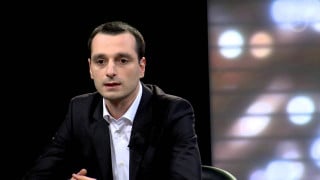On 3 October 2014, Mayor of Tbilisi, Davit Narmania, and members of Tbilisi City Council visited the Public Broadcaster of Georgia. The talk show mainly discussed Tbilisi’s old and new infrastructural projects. Whilst talking about the projects, the Mayor stated that he was left with an almost empty budget. As a response to this, a member of the Tbilisi City Council asked the Mayor the following question: “Davit Narmania stated that he was left with an almost empty budget. I would like to ask Mr Narmania a question: How can he, in terms of the ‘empty’ budget, afford to fund the rehabilitation work of the Chancellery building territory by GEL 1.2 million, lighting of the Chancellery building by GEL 450,000 and lighting of the territory of the Ministry of Internal Affairs of Georgia by GEL 460,000. In terms of the empty budget, he spends GEL 2 million on the projects which are aimed for the comfort of the Ministers.”
FactCheck took interest in this statement and verified its accuracy.
It should be pointed out from the very start that Mr Abesadze’s statement is a response to accusations by the new government of Tbilisi towards the old management of Tbilisi City Hall. According to Davit Narmania, the old management spent the budget resources entirely. In response to this accusation, Irakli Abesadze said that if the budget is empty, then Tbilisi City Hall must not be able to spend anything and if only a little amount of money is left in the budget, it should not be spent solely on the rehabilitation work of the Ministries.
In order to find out whether or not Davit Narmania was actually left with an empty budget, we addressed Tbilisi City Hall with an official letter and took interest in the income and spending parts of the Tbilisi City budget in July 2014 (the second round of the Tbilisi Mayoral Election was held on 12 July 2014).
According to Tbilisi City Hall’s response, received only after 1.5 months, the overall amount of the Tbilisi City budget equalled GEL 772,424,600 in 2014 and the implementation of the income and spending parts of the budget by July 2014 looked like this:
As we can see, the income part of the budget was GEL 5 million more by the time of Mr Narmania’s election which means that it was not “empty.”
We also looked into the income and spending parts of the Tbilisi City Hall budget for the first nine months of 2014:
As we can see, the implementation of the income part of the budget is higher (95.5%) than that of the spending part (82.8%) and the income of the budget was GEL 35,634,800 more than spending which indicates the existence of money in the budget.
FactCheck also took interest in whether or not any of the projects (infrastructural or social) were stopped due to the lack of finances in the Tbilisi City budget. According to the information of Tbilisi City Hall, none of the projects has been stopped for this reason in 2014. What is more, funding of some of the projects has even been increased in terms of the 2014 budget. Namely, a one-time material aid for socially vulnerable families with three, four, five or more children was increased by GEL 165,580 whilst the funding of communal vouchers increased by GEL 1,100,000.
As for the rehabilitation and lighting of the Chancellery building and the Ministry of Internal Affairs of Georgia, according to the response from Tbilisi City Hall, the tender documentation for the lighting of the Chancellery building and the Ministry of Internal Affairs of Georgia has been prepared for the following probable sums: installing the outdoor lighting of the Ministry of Internal Affairs building – GEL 434,000 and installing decorative lighting for the Chancellery building – GEL 450,000. The overall value of the rehabilitation of the building is GEL 1.2 million. The project included the rehabilitation of a park on the territory of the building, repairs of the facades of nearby buildings and the rehabilitation of the asphalt surface near the building.
According to Tbilisi City Hall, other infrastructural projects have been and are being implemented since the election of Mr Narmania. For example, the construction and rehabilitation of roads (GEL 7,329,881), the construction and rehabilitation of engineering facilities and infrastructural objects (GEL 162,556), the building of houses and the rehabilitation of damaged buildings (GEL 146,662), the installation and rehabilitation of the outdoor lighting system (GEL 3,426,393), looking after the drainage network (GEL 521,314) and the installation and rehabilitation of heating and hot water systems in pre-school educational facilities (GEL 17,665,692).
Conclusion
The difference between the income and spending part of the Tbilisi City budget was GEL 5 million by the time of Davit Narmania’s election whilst according to the nine-month budget report this difference is about GEL 35.6 million. The Tbilisi City budget was not empty, as stated by Mr Narmania. In addition, none of the planned projects has been stopped due to the lack of funding in 2014.
Funding has indeed been allocated for the rehabilitation of the Chancellery building (GEL 1.2 million), outdoor lighting of the Chancellery Building (GEL 450,000) and the lighting of the Ministry of Internal Affairs of Georgia building (GEL 434,000).
FactCheck concludes that Irakli Abesadze’s statement is TRUE.
|
Category |
9 Month Plan |
7 Month Implementation |
Implementation (%) |
|
Income |
520,166,500 |
392,867,600 |
75.5 |
|
Spending |
554,911,600 |
387,760,600 |
69.9 |
|
Category |
9 Month Plan |
Cash Execution |
Implementation (%) |
|
Income |
520,166,500 |
495,285,500 |
95.2 |
|
Spending |
554,911,600 |
459,650,700 |
82.8 |
|
Changes in Remainder |
34,745,100 |
-35,634,800 |








